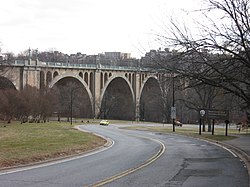Taft Bridge | |
|---|---|
| Coordinates | 38°55′18″N 77°03′01″W / 38.921652°N 77.050371°W |
| Characteristics | |
| Total length | 901 feet (275 m) |
William Howard Taft Bridge | |
 | |
| Location | Connecticut Avenue, NW over Rock Creek Washington, D.C. |
| Coordinates | 38°55′14″N 77°2′59″W / 38.92056°N 77.04972°W |
| Built | 1906 |
| Architect | Edward Pearce Casey |
| Engineer | George S. Morison |
| Architectural style | Classical Revival |
| NRHP reference No. | 03000584[1] |
| Added to NRHP | July 3, 2003[2] |
| Location | |
 | |
The Taft Bridge (also known as the Connecticut Avenue Bridge or William Howard Taft Bridge) is a historic bridge located in the Northwest quadrant of Washington, D.C. It carries Connecticut Avenue over the Rock Creek gorge, including Rock Creek and the Rock Creek and Potomac Parkway, connecting the neighborhoods of Woodley Park and Kalorama. It is named after former United States president and Supreme Court Chief Justice William Howard Taft, and sits to the southwest of the Duke Ellington Bridge.[2][3]
Four statues of lions by sculptor Roland Hinton Perry, known as the Perry Lions, are placed in pairs at both ends of the bridge. On July 3, 2003, the Taft Bridge was added to the National Register of Historic Places.[1]
- ^ a b "Weekly List of Actions Taken on Properties: 6/30/03 through 7/05/03". National Park Service. July 11, 2003. Retrieved July 16, 2009.
- ^ a b "National Register Information System". National Register of Historic Places. National Park Service. March 13, 2009.
- ^ "District of Columbia - Inventory of Historic Sites" (PDF). Government of the District of Columbia. September 1, 2004. Archived from the original (PDF) on June 18, 2009. Retrieved July 16, 2009.
